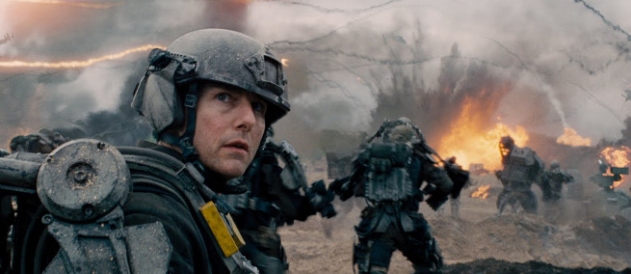
Edge of Tomorrow has been called “Groundhog Day Goes Sci-Fi.” This latest Tom Cruise vehicle imagines the actor as a reluctant super-soldier of the future who repeats the same day over and over again, not unlike Bill Murray’s sour-faced weatherman in the 1993 comedy. And while the stakes here are a bit higher—global apocalypse rather than romantic coupling—the theoretical science behind the scenarios is actually quite similar.
Hollywood has often used time travel as plot device, but in Groundhog Day and Edge of Tomorrow, there are no time machines or worm holes. Rather, these films offer a more complicated conception of time, less akin to old-fashioned interpretations of Albert Einstein’s standard theory of relativity and its space-time continuums, and more like newer ideas related to quantum theory.
Sloan Science and Film spoke with Amherst College professor Kannan Jagannathan, a theoretical physicist and expert in relativity, cosmology, and quantum physics, about time loops, the “Many-worlds” interpretation of quantum mechanics and the scientific plausibility of destiny.
Science and Film: So, in Edge of Tomorrow, much like Groundhog Day, Tom Cruise’s character repeats the same day over and over again. Every time he dies, he goes back to one specific point early in the day; time essentially re-sets. How plausible is this?
Kannan Jagannathan: When we look at these movies, we might think about time loops and time travel, but there are problems with time loops in classic relativistic physics. The classic issue with the time loop—the so-called grandfather paradox—is that if you can travel back in time, you can murder your grandfather before you were born. One resolution that philosophers have come up with is that you can travel back in time, but you can’t change anything. By design, there will be no observable consequences. Various science fiction films try to split the difference between what’s impossible and metaphysically possible. Most things are left as they are, but there are small things that the time traveler can affect, which you can see in not just Groundhog Day, but Back to the Future, Timecop, or even something less sophisticated, like Bill and Ted’s Excellent Adventure.
SF: But in Groundhog Day and Edge of Tomorrow, it’s not exactly time travel, right? It’s the idea that time is not chronological or linear.
KJ: Yes, that’s true. There is no actual time travel. In fact, many of these movies don’t actually portray the actual backwards motion in time; it’s always blurry and vague. If people took it seriously and wanted to render it cinematically, it would be rather revolting: If somebody’s eating, and you run it backwards in time…could be pretty bad.
SF: So is this idea of reliving the same day more interesting from a theoretical perspective?
KJ: Yes, I think we can leave time loops and relativity alone and go to the quantum theory. Because quantum theory deals only with the probabilities of various outcomes of measurements, the state of a quantum system before it is measured can be in this strange super-position of possibilities. Energy can be three units or five units; but in the state before the measurement is viewed, there is no fact of the matter: it’s both three and five units, with certain odds. That’s the peculiarity of the quantum theory. And the standard so-called Copenhagen interpretation just says that’s the way it is: don’t ask any questions.
Of course, people have been asking questions. In particular, the Bones interpretation, developed by David Bones, is the idea that the world divides. Sometimes, it’s called the “many worlds” interpretation. It says: The state of the system before the measurement is made is called the superposition of different units of energy, and whenever any interaction occurs in the system, the world divides. And not just the system, but the whole world divides—into one in which the energy of the system is three units and one in which the energy of the system is five units. Now this is a complicated speculative idea, and most physicists don’t go for it, because of its prodigality. But I thought some of these movies with the same day or same duration represented with multiple possibilities, could be viewed in this “many worlds” way.
So, for example, the Bill Murray character in Groundhog Day is in super-positional states at some early time and what we are shown on screen in theater time are really parallel worlds that he inhabits. This interpretation doesn’t quite hold tightly with what you see on the screen, because I don’t think the authors had that in mind. But I think it offers greater scientific coherence than time travel itself, if that makes sense?
SF: I think it does, and it applies to Edge of Tomorrow, as well. Is the “many worlds” interpretation infinite or multitudinous? In the film, Tom Cruise seems to go through the same scenario a seemingly infinite number of times.
KJ: It could be infinite. This is the weakness of the interpretation. Physicists are generally repulsed by this idea, because of the implication that the number of worlds is enormously high. It may not be infinite, but the number of worlds that would be produced in this interpretation is more on the order of Googleplex. People often ask how many days were depicted in Groundhog Dog. There is no clear number there. You can keep count in the beginning, but then you lose track of it. And this could be just a small portion of the possible worlds that are depicted.

SF: It’s exactly the same in Edge of Tomorrow, so I think it’s an interesting application of the theory. I wonder about how these films build to an almost predetermined conclusion. Doesn’t that go against quantum theory?
KJ: No. One thing that quantum theory allows for is that not only can worlds bifurcate, but they can be brought together. One recovers the original super-positional states. In the simplest cases that have been done in the laboratory, you take a source of photons and send it through a beam splitter, and it takes two paths. But you can choose not to measure which of the two paths the photon follows; and when you reconstruct the beams together at the end you’ve recovered the original state of the superposition of the two possibilities. And that’s not part of speculative physics, that’s a well–established experimental result.
SF: So the idea of destiny is not necessarily scientifically inaccurate?
KJ: It’s not. For instance, in Groundhog Day, if Bill Murray’s character is meant to turn from a jerk into a nice person, the manner in which that is accomplished, through these multiple worlds that are then brought together, could work. Again, this is many levels beyond what the actual science would support. But I find it intriguing.
SF: Can you say what is going on now in research on time or particle physics that is exciting to you?
KJ: This is really an exciting time, both from the side of cosmology and particle physics. I’m thinking, in particular, of the discovery of the accelerating universe and the reported detection of gravitational waves due to the inflational scenario. In some ways, the excitement is that there are so many pressing questions that we need answers to. What is life beyond the standard model of particle physics? Everybody believes that the standard model is just a partial picture. But the frustrating thing is that the standard model has been so triumphant for over the last thirty years. And every time there is an opportunity where an experiment will show us something that will expand the standard model, the standard model predictions are right on the money. That can’t last forever.